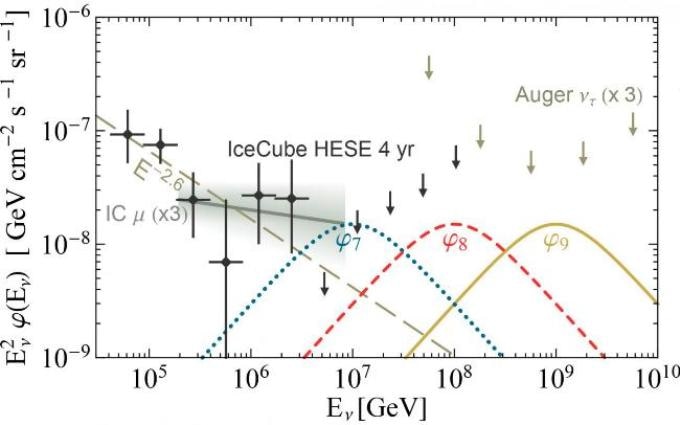Jun 21 2018
The IceCube detector is a research center situated at the South Pole to identify neutrinos arising from the cosmos. This center was commissioned only eight years ago. Now, three years later, it started to register the first historic results.
 This figure shows various neutrino fluxes as a function of neutrino energy. The neutrino energy is expressed in GeV (1 GeV = 1 billion eV). IceCube data points and upper limits of astrophysical neutrino fluxes from other experiments are also shown here. (Image credit: ill./©: Matthew D. Kistler and Ranjan Laha)
This figure shows various neutrino fluxes as a function of neutrino energy. The neutrino energy is expressed in GeV (1 GeV = 1 billion eV). IceCube data points and upper limits of astrophysical neutrino fluxes from other experiments are also shown here. (Image credit: ill./©: Matthew D. Kistler and Ranjan Laha)
The high-energy neutrinos, detected by the IceCube detector, provide completely new possibilities for elucidating the way the universe works. "These neutrinos with their considerable energy are cosmic messengers we have never encountered before and it is extremely important that we understand exactly what they are telling us," explained Dr. Ranjan Laha of Johannes Gutenberg University Mainz (JGU).
The Mainz-based physicist, in association with a coworker at Stanford University in the USA, has proposed a new theory on what this interstellar message carrier might be. Both physicists have estimated that the high-energy neutrinos, which have been detected, could possibly be the track of a high-energy tau particle that transported the IceCube detector.
Neutrinos are actually particles that have little to no mass, and as a result they can pass through a material almost inconspicuously and are also very hard to detect. However, this is the reason that makes these mysterious particles especially vital to science, because they emanate from high-energy astrophysical phenomena, including exploding stars, in the extreme depths of space from where they travel to the Earth planet almost unhindered, providing a better understanding of what exactly is occurring out there.
With regards to the IceCube Neutrino Observatory, the separate detector elements are concealed in the Antarctic ice and are distributed over an ice volume of a cubic kilometer, where they are suitably protected against the effects of potential interference factors. For the first time, the project team announced the detection of high-energy neutrinos from space in 2013. Since then, various similar events have been registered. The IceCube team, which is accountable for the scientific program, includes scientists from JGU and comprises of 300 physicists from 49 institutions situated in 12 countries.
High-energy track presumably not generated by a muon neutrino
Ranjan Laha of Mainz University and Matthew Kistler of Stanford have studied the numerous events, with an aim to explain a certain enigma: the IceCube sensors were able to detect a particle with unusually high energy in June 2014. Calculations revealed that the particle was able to deposit 2.6 petaelectron-volts (PeV), that is, 2.6 quadrillion electron-volts. For comparison purposes, proton collisions in the Large Hadron Collider (LHC), the world’s largest particle accelerator, at CERN takes place at an energy of only 13 trillion electron-volts. "The track registered in June 2014 throws up all sorts of questions," said Laha, emphasizing that this is the maximum high-energy event to be registered so far. "The foremost question is what sort of neutrino would leave behind a track like this." Electrons, muons, and tau neutrinos are three types of neutrinos.
Seeking an answer, both researchers initially based their analyses on the usual assumption that a muon has produced the track. After colliding with an atom nucleus, a muon neutrino had probably changed into a muon and hence it is likely that it has been captured by the IceCube’s optical sensors. "However, we have demonstrated that this hypothesis is constrained," described Laha. Yet, an entirely new and unconventional interpretation of the event was proposed by the two physicists - that is, the track may be that of a high-energy tau lepton. In order to be registered by the IceCube detector with an energy of 2.6 PeV, the so-called tau neutrino would need to have a minimum initial energy of 50 PeV.
"A tau particle that can pass through a detector with a length of one kilometer without decaying and furthermore releasing energy of 2.6 PeV must originate from a neutrino with significantly greater energy," said Laha. "Assuming this is the case, this opens up completely unexpected possibilities, namely that astrophysics should start looking for neutrinos with energy of up to 100 PeV."
Furthermore, both researchers reached a conclusion that a component of the neutrino spectrum, formerly unknown to astrophysicists, probably caused the 2.6 PeV event. When it comes to the events recorded by the IceCube detector, a certain continuity is to be anticipated. Yet, the gap between the other registered data and the stated event with the highest energy captured so far is extraordinarily large.
"We still don't really know what caused the 2.6 PeV track. It is generally assumed to be a transiting muon. We show that it is also possible to be a transiting tau particle," concluded Laha. "We consider this event so significant that we believe it should be examined more closely. And we need more data to be able to discover more and decode this message sent us by the cosmos."
Ranjan Laha is a postdoctoral researcher and a member of the work group of Professor Joachim Kopp, Professor of Theoretical Particle Physics at the Mainz-based Precision Physics, Fundamental Interactions and Structure of Matter (PRISMA) Cluster of Excellence.